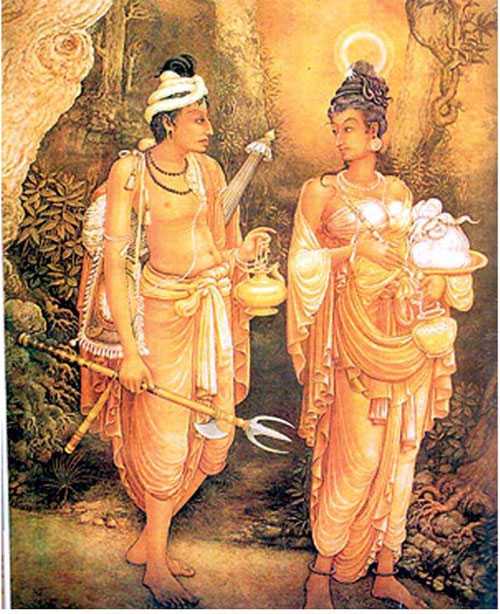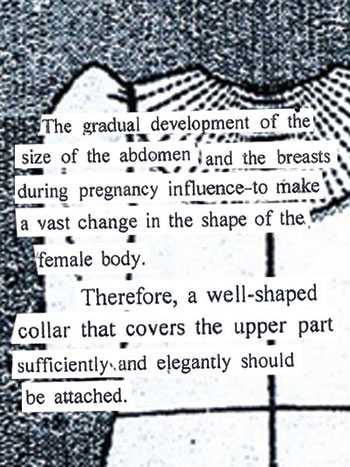Wednesday Nov 27, 2024
Wednesday Nov 27, 2024
Wednesday, 25 July 2018 00:00 - - {{hitsCtrl.values.hits}}

Kelaniya Temple Murals illustrating Prince Danta and Princess Hemamala with the Tooth Relic sacred to Buddhists


Excerpts from the Ministry of Education Circular Dress Codes for Pregnant Teachers, May 2018
Nearly 20 years ago, Cat’s Eye(i) wrote about the peculiar stereotypes expected of ‘good Sri Lankan women’ who are also not just women, but ‘wives and mothers of the nation’. This column drew public attention several times to the sexist double standards and the quick and ready social stigma that follows if and when women ‘transgress’ these boundaries.
Two decades later, it appears little has changed.
A circular issued in May this year from the Ministry of Education(ii) went into great detail, and clearly great pains, to specify what pregnant teachers should wear in school. The circular detailed the space and volume required of this pregnant teacher’s ideal dress, the need for ‘a box-pleat’ to accommodate her growing waistline, a ‘round neckline’ that is ‘not too deep’ however for ‘decency’, compulsory sleeves, invisible zippers, and all in a choice of colour that would enhance the ‘brownish-gold’ of Sri Lankan skin.
The circular – with 13 pages of drawings of this ideal dress – posted online by the Ministry was their response following an incident of harassment of a pregnant woman at the Western Province Education Department due to the fact that she wore a knee length skirt to a scheduled meeting(iii). This circular was later rescinded after incensed protests by teachers.
 This is but one of many recent instances of policing and control of women’s appearance. Last year, a respected international prosecutor was asked to cover her arms in Parliament. Past vice chancellors of the Universities of Kelaniya and Sri Jayawardenapura wanted women staff members to wear saree. A number of schools that included Royal College, Lyceum International, St. Joseph’s College and St. Peter’s College took it upon themselves to impose a dress code on parents, particularly mothers of children, and faced both support and public ridicule.
This is but one of many recent instances of policing and control of women’s appearance. Last year, a respected international prosecutor was asked to cover her arms in Parliament. Past vice chancellors of the Universities of Kelaniya and Sri Jayawardenapura wanted women staff members to wear saree. A number of schools that included Royal College, Lyceum International, St. Joseph’s College and St. Peter’s College took it upon themselves to impose a dress code on parents, particularly mothers of children, and faced both support and public ridicule.
The Federation of Inter-University Student Unions imposed a dress code on freshers as part of the abusive practice of ragging, and it is also known that female Muslim students have been forced to wear the abaya by senior students at some universities. Women have sometimes been barred access to schools and other institutions by security guards who have been retained to protect these institutes.
Women are often made to adhere to a dress code that is neither in the law of our country nor justified by arguments of culture or decency. Given the energy it entails, it appears there is some imminent and high-risk threat posed by a woman in a sleeveless jacket or a short skirt, or if they are not in box pleats during pregnancy. Women’s limbs – particularly arms and legs – seem to be objectionable.
Clearly there is confusion around the mid-riff. According to some, part of the mid-riff can be exposed when wearing a saree, though it’s unclear to us at Cat’s Eye, exactly how much is considered ‘decent’. However, the same mid-riff is taboo when it comes to a short top and pants. Women are instructed, guided, cajoled and threatened about what is considered an appropriate attire by families, peers, schools, religious leaders, political leaders and the media.
Behind this fascination around the length of a hemline, the perfect puff of a sleeve and the height of a saree jacket however, is one of control. The rescinded circular by the Ministry of Education, reiterates the need to protect the ‘respectability’ of women through dress, her ‘respectability of profession as a teacher’ and to protect tradition and culture. Women are seen as needing to bear the cross of culture for their societies. But what is this culture exactly?
Certainly Sri Lanka’s historic culture as far back as the 5th century depicts women (presumably from royalty), in public with both breasts exposed and a bare mid-riff. The Dodanduwa temple, built as late as in the Kandyan period, portrays an aristocratic woman with bare breasts offering alms to priests. Even the Kelaniya Temple mural of Prince Dantha and Princess Hemamala carrying the Tooth Relic to Sri Lanka shows Princess Hemamala wearing what would today be called a cropped top. Where then does this preoccupation with women’s clothing come from? One has to only look at the intervening colonial period with its British Victorian morals, which influenced local cultures. And so, our much revered local traditions of ‘decent’ dress are instead a British import. There are some dangerous assumptions in all of this policing around what women should wear. For one, it reinforces the notion that women should not be or do not need to be respected unless they conform to these patriarchal notions of culture and femininity decided upon and imposed by these institutions.
Secondly, it feeds the idea that the visible parts of women’s bodies incite sexual desire in men and boys and therefore, it is women’s attire that leads to violence against them and therefore they are responsible for it. This victim blaming allows the real culprits to get away time and again, or be forgiven by a society that sees women and their clothes as the problem instead. Instead of regulating women’s appearance and dress, we should be teaching men and boys respect for women and self-control.
So perhaps the next time you feel inclined to think a woman is showing too much mid-riff or a tad too much of an arm or a leg, it’s worth a pause to ask yourself, “is it me?” instead.
(The Cat’s Eye column is written by an independent collective of feminists, offering an alternative feminist gaze on current affairs in Sri Lanka and beyond.)
Footnotes
i De Alwis, M. (ed) (2000) Cat’s Eye: A Feminist Gaze on Current Issues, Cat’s Eye Publications, Colombo
ii Ministry of Education (2018) Introducing a suitable dress for the Female Teachers during their pregnancies, Circular No.21/2018, Sri Lanka.
iii Pregnant Educator Turned Away from Provincial Education Department for wearing a knee length skirt, Asian Mirror, 16 May 2018 (Available online: http://asianmirror.lk/news/item/27434-pregnant-educator-turned-away-from-provincial-education-department-for-wearing-a-knee-length-skirt)